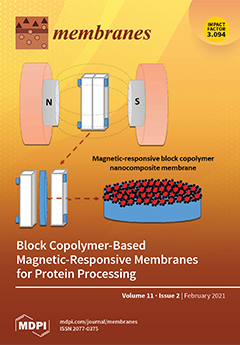Herein, composite nanofiber membranes (CNMs) derived from UiO-66 and UiO-66-NH
2 Zr-metal-organic frameworks (MOFs) were successfully prepared, and they exhibited high performance in adsorptive fluoride removal from aqueous media. The resultant CNMs were confirmed using different techniques, such as X-ray diffraction (XRD), field
[...] Read more.
Herein, composite nanofiber membranes (CNMs) derived from UiO-66 and UiO-66-NH
2 Zr-metal-organic frameworks (MOFs) were successfully prepared, and they exhibited high performance in adsorptive fluoride removal from aqueous media. The resultant CNMs were confirmed using different techniques, such as X-ray diffraction (XRD), field emission scanning electron microscopy (FE-SEM), and Brunauer–Emmett–Teller (BET) in addition to Fourier-transform infrared spectroscopy (FTIR). The parameters that govern the fluoride adsorption were evaluated, including adsorbent dose, contact time, and pH value, in addition to initial concentration. The crystalline structures of CNMs exhibited high hydrothermal stability and remained intact after fluoride adsorption. It could also be observed that the adsorbent dose has a significant effect on fluoride removal at high alkaline values. The results show that UiO-66-NH
2 CNM exhibited high fluoride removal due to electrostatic interactions that strongly existed between F
− and metal sites in MOF in addition to hydrogen bonds formed with MOF amino groups. The fluoride removal efficiency reached 95% under optimal conditions of 20 mg L
−1, pH of 8, and 40% adsorbent dose at 60 min. The results revealed that UiO-66-NH
2 CNM possesses a high maximum adsorption capacity (95 mg L
−1) over UiO-66 CNM (75 mg L
−1), which exhibited better fitting with the pseudo-second-order model. Moreover, when the initial fluoride concentration increased from 20 to 100 mg/L, fluoride adsorption decreased by 57% (UiO-66 CNM) and 30% (UiO-66-NH
2 CNM) after 60 min. After three cycles, CNM revealed the regeneration ability, demonstrating that UiO-66-NH
2 CNMs are auspicious adsorbents for fluoride from an aqueous medium.
Full article






